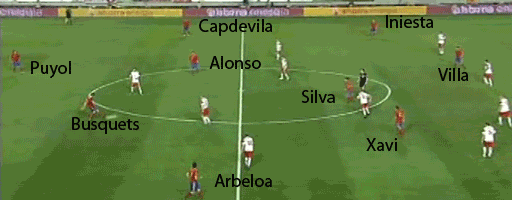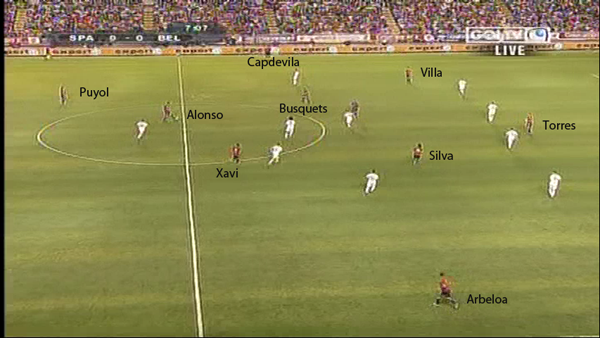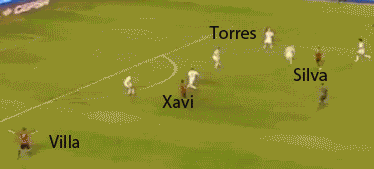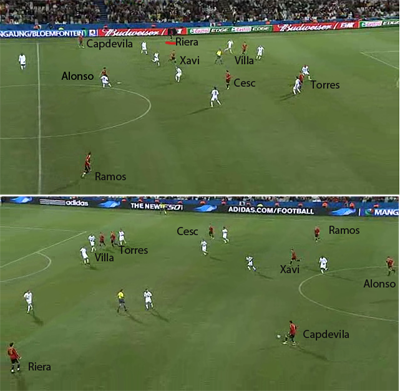The Back 4 and Goalkeeper
I'll start with the back five to get them out of the way. There are some questions about the lineup at those positions, but they don't affect the style of play or the formation Spain will use.
Spain are very deep at keeper. Iker Casillas will be the number one, with Pepe Reina at backup and Victor Valdés available if something happens to the other two. All three are widely considered world class. Without looking deeply into it, I'd guess that Valdés would start for 20-25 sides in the competition and he doesn't even figure to play if there is nothing at stake in the third match in the group stage.
At center back, Del Bosque will choose two of Marchena, Puyol, Piqué and Albiol. I don't think there is much in it. I'd probably go with Marchena and Piqué, but it doesn't really matter. Capdevila (pro tip: pronounce the L in Capdevila like an L in English. The last two syllables are VEE-lah) has a solid hold on the left-back spot. On the right, Sergio Ramos is probably going to start over his Real Madrid teammate Álvaro Arbeloa.
The Front 6
The front six is where it gets very interesting. I break the players into 5 groups. Here they are. The groups go from front to back, within each group I've sorted them by what I feel is the most likely to least likely to start.
Strikers - David Villa, Fernando Torres*
True Wingers - Jesús Navas, Juan Manuel Mata
All-Around Attackers - David Silva, Andrés Iniesta, Cesc Fàbregas
Xavi - Xavi
Defensive Midfielders/Deep-Lying Playmakers - Xabi Alonso, Sergio Busquets
* may flip if and when Torres is fully fit.
Navas and Mata should start on the bench in all the matches that matter. I'll discuss them a bit more later because I think they will be important coming off the bench, especially Navas. The only player in the front six that is guaranteed to start all matches with something at stake is Xavi. For the others, it depends heavily on the formation Del Bosque chooses as well as small tweaks he might make.
Formations
A lot of the focus has been on whether to run one striker or two. I don't think that's an important division, for reasons that should become clear later. Instead I will break them down into formations where both Xabi Alonso and Sergio Busquets are starting, and those which feature only one of them. Del Bosque seems inclined to start with both, so I'll look at those first.
4-3-3

This seems very likely to be the formation Del Bosque will use in the opener against Switzerland on the 16th. Here are the roles of each group:
Forwards - Villa plays a pretty standard center-forward position. Of the two on the wings, Silva will be the more flashy but Iniesta's job is more interesting for the tactical enthusiast. Much more than you could say about Euro 2008, Silva's position could legitimately be described as winger, albeit one with A LOT of freedom. He plays on the right side, but is wont to make runs across the pitch, back to the midfield and to goal. Like the other attacking players, he is great at finding holes in the defense and making runs into them. Iniesta provides width on the left. If the ball is in the middle or on the right, you can expect him to be very close to the left touchline, outside of the opposing right back. He moves off that line when Spain get the ball forward on the left, especially when it's played to him. At that point, the attack becomes more fluid. Like Silva, he takes advantage of his knack for finding holes in the defense and incredible vision to find teammates making runs. A recent example of this was the second goal against Poland.
Midfielders - I didn't bother to draw the arrows for Xavi, but they would be in every direction. The same is true for Alonso to a lesser extent. The two of them move all around the middle of the park, exchanging positions often. Xavi is typically the more advanced of the two, but when Spain have the ball Xabi Alonso goes forward to support the attack as well. Busquets will also move up on occasion, but not often. He has a more defensive role, playing deeper and getting fewer touches.
Defenders - The center backs play pretty typically. The only thing worth commenting on is that they will slide out pretty wide when the fullback on their side makes a forward run. Both fullbacks push forward. When the ball is on the other side, they provide midfield width. For the most part, they only make runs into the attacking areas when the ball is on their side. They also rarely make surging forward runs with the ball, like you'd typically see Brazilian fullbacks do.
Here is a short clip showing what happens on the pitch. It's short, but there is a lot to see, so I'd recommend watching it a few times.

It's set to loop, the start is frozen for a few seconds with the names. Just before this, the ball was played by Casillas to Arbeloa, who took a couple dribbles forward before playing it over to Busquets. Busquets took one touch and is about to pass the ball forward to Silva, as you'll see.
The first thing to notice is where Iniesta is. The ball has just moved from the right back to a midfielder and yet he is within a couple yards of the left touchline. In previous formations, he would have been somewhere around a couple yards deeper than Villa's position. Xavi's positioning and movement are pretty typical as well. He starts in a fairly advanced position for him, in position to receive a pass from Arbeloa. Once Arbeloa plays it in to Busquets he waits for Silva to finish his run before moving into the hole created by the defender following Silva out.
Silva's positioning and skill both on and especially off the ball are on full display. He has dropped back and into a more central location at the start, before making a short run even deeper to find some space in the middle. Never stopping his run, he is able to two-touch it right to Alonso's feet. He then turns and makes another run up and to the left, again finding space. His ability to make these sorts of runs in the middle, as here, and further up the pitch are a huge part of Spain's success.
Notice that for Poland all six midfielders and forwards are defending in the area and they are still getting overrun by four Spaniards because of the passing skill and, as importantly, movement. In this case it was Silva and Xavi, but it could easily have been Xabi Alonso, Iniesta or Fàbregas. You can see why they are capable of playing their most defensive formation without having much of a dropoff in scoring. The most impressive thing about this clip is that something like this probably happens 50 times a match.
4-3-3, Villa on the Wing

I think this is the most likely formation that involves both Villa and Torres being on the pitch together. That doesn't make the debate about having just one or both of them moot, but it does change it. There are still some benefits and drawbacks, but instead of discussing whether it's better to have two center forwards or just one it really comes down to Villa vs. Iniesta on the wing. As a sidenote, this will likely be a very important issue for Barça, especially if they don't sell Zlatan.
The other players have similar roles as in the 4-3-3 above. The only one that is different is Capdevila, whom we can expect to be even more aggressive in his forward runs. Look for him to overlap when Villa gets the ball. Without the ball, Villa has the same job as Iniesta - provide width. When it comes to his side, he's going to be more direct, looking for space in scoring areas. He is also capable of setting up teammates.
Obviously Villa is much more of a scoring threat than Iniesta. When the ball is on the right or in the middle, this presents the other team with a Sophie's choice that wouldn't be nearly as tough with Iniesta. If the defense stays compact then Spain can play it across or diagonally to Villa, who may find himself with the ball and only one defender near him - scrambling to get in position. That's pretty devastating. However, if they stay spread out then that leaves a lot of room for Silva, Torres, Sergio Ramos and whichever of Xavi and Xabi Alonso are in position to make a forward run. When the ball is on Villa's side it's still an issue. He often proves too much for the fullback. The defense has to decide whether to have a center back in position to help, which opens up space for Silva, Torres et al in the middle. If they don't then you can expect Villa to have a big night.
To summarize, putting Villa on the wing makes Spain both more direct and more dangerous in the attacking third. With Iniesta they put pressure on waiting to exploit a defensive mistake, with Villa they force the issue. The drawback is that they will control the ball just a bit less - Villa is not as good as Iniesta at moving the ball. They will still dominate possession, after all Silva, Xavi and Xabi Alonso are still on the pitch, and this effect is lessened by Iniesta playing the super-wide role. He's not helping with the short-passing game on the right.
Here is a zoomed-out shot of how it looks on the pitch and a clip that shows how tough it can be to defend.


Sorry for the poor quality. Just before the clip, it's a fairly standard buildup. After knocking the ball around on the right, a center back has played it up to Silva from just ahead of the center line. Silva is cutting in with the ball. Torres fills the space left behind him while Xavi makes a forward run into the middle of the defense. You can see that David Villa has nobody within a dozen yards of him and has both arms out calling for the ball. When he gets it, Capdevila makes a strong overlapping run which pulls the center back out, giving Villa more than enough space for the nice finish. Once Silva made his run the defense was left to pick its poison. Had they been in better position to deal with Villa then Torres, Xavi or Silva himself would have had a great chance to score.
To be honest, I started out with the view that playing only one of Torres and Villa is the way to go but after watching matches and giving it some thought I think this is the best formation if Torres is fit.
Formations with Only One of Busquets and Xabi Alonso
4-2-3-1
This is the quickest one to cover - it's a pretty standard fluid 4-2-3-1. Xavi joins whichever of Xabi Alonso and Busquets in the central midfield. It's basically the same as when they used it in Euro 2008. Iniesta, Fàbregas and Silva move around in the attacking midfield. Other than getting all three of these great players involved, the strength of this formation is that it's unpredictable. Any of them could make that forward run and, of course, the defense has Villa or Torres to worry about up top plus Xavi and the fullbacks coming forward.
4-3-3/4-4-2 Hybrid

This formation is pretty interesting. I call it a hybrid of a 4-4-2 and 4-3-3. The three midfielders, Xavi, Alonso and Silva in the diagram above, play more or less like a normal 4-3-3 midfield while the left winger and forwards, Iniesta, Villa and Torres, play how you would expect them to in a traditional 4-4-2. You could call it a 4-4-2 with a tucked in right midfielder playing deeper than typical, I suppose. In this formation, they don't completely abandon the right side - Silva or Xavi often go out there and the fullback provides support as well. Ramos tends to go further forward, including some forward runs looking for a diagonal ball from the other side of the pitch. However, there is very rarely someone up near the defensive line giving the opposition left fullback something to think about. In contrast, the left winger is consistently very wide much like I described Iniesta in the first formation above.
This asymmetry leads to an interesting dynamic where their attack is very compact on one side, but they spread the defense out on the other.
Here are two shots of it in action against the United States in the Confederation Cup.

In the top shot, you can see their locations when the ball is on the left-hand side. Cesc, listed as the right midfielder, is just to the left of center. The only player on right half of the pitch is Sergio Ramos. For that matter, he is the only player for either team more than a couple yards to that side of center. In the bottom shot, the ball has just been played to Capdevila, I believe from Alonso. The players haven't had a chance to move, so this captures their position when attacking the right side. Riera is not only on the other side of center, he appears to be on the other side of the 18-yard box. Notice how much more spread out the defense is in the bottom shot.
To be honest, I'm not sure how much I like this formation. Since there is an extra man on the left, that is the side they tend to attack. It is also the side where the defense is pretty tight. That's common to all of these formations because Silva is given the free role. However, it's worse in this case because both Torres and Villa are in there taking up space. When there is only one of them, or Villa is on the wing, there is more room to make runs with and without the ball. Also, the results aren't great. This is what they used in the Confederations Cup. The Confederations Cup isn't all that valued, but much more so than a friendly. I think we can take something from it and Spain had some pretty bad results. Obviously there's the loss to the US, but they also beat South Africa 2-0 and Iraq only 1-0. Crushing New Zealand 5-0 was the only match of the four that went as well as expected.
The formations with both Xabi Alonso and Busquets give them more protection from counterattacks and with the 4-2-3-1 they have a more free-flowing attack. Given Torres's fitness concerns and Jesús Navas emerging as a great sub option and even potential starter, I don't think we'll see this formation.
Substitutes
Who the subs are depends a lot on the starting formation. I strongly suspect that Del Bosque will use one of the first two as his basic formation. That leaves one or both of Iniesta and Cesc starting out on the bench. This seems crazy, but it's tough to find an alternative that is as balanced. I think Xabi Alonso will be the key because he is essentially replacing one of those great players. If he can provide the defensive support expected of him and help to push the attack alongside Xavi then it will all work out well. If he struggles with either of those then Spain will struggle and either he or Busquets will likely come off at halftime.
I'm biased since he's my favorite player and plays for my favorite club, but I think Jesús Navas could potentially be the most important sub for any team in the competition. His pace, energy and runs with the ball bring something the starters don't have. Especially against the kind of disciplined, patient sides that give Spain problems his spark coming in off the bench could be just what they need to turn a game around or break the deadlock. The same is largely true of Mata, but Navas seems to be in better form at the moment and the more likely of the two to be brought on.





